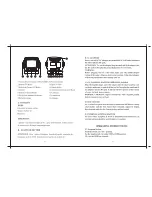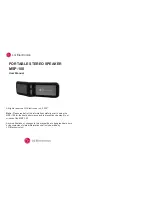
SKU 93881
For technical questions, please call 1-800-444-3353
PAGE 16
TROUBLESHOOTING
PLEASE READ THE FOLLOWING CAREFULLY
THE MANUFACTURER AND/OR DISTRIBUTOR HAS PROVIDED THE PARTS LIST AND ASSEMBLY
DIAGRAM IN THIS MANUAL AS A REFERENCE TOOL ONLY. NEITHER THE MANUFACTURER OR
DISTRIBUTOR MAKES ANY REPRESENTATION OR WARRANTY OF ANY KIND TO THE BUYER THAT
HE OR SHE IS QUALIFIED TO REPLACE ANY PARTS OF THE PRODUCT. IN FACT, THE MANUFAC-
TURER AND/OR DISTRIBUTOR EXPRESSLY STATES THAT ALL REPAIRS AND PARTS REPLACE-
MENTS SHOULD BE UNDERTAKEN BY CERTIFIED AND LICENSED TECHNICIANS, AND NOT BY
THE BUYER. THE BUYER ASSUMES ALL RISKS AND LIABILITY ARISING OUT OF HIS OR HER
REPAIRS TO THE ORIGINAL PRODUCT OR REPLACEMENT PARTS THERETO, OR ARISING OUT OF
HIS OR HER INSTALLATION OF REPLACEMENT PARTS THERETO.
Problem
Possible Cause
Possible Solution
Engine will not start.
1. Low on fuel or oil.
2. Engine power switch is in the
OFF position.
3. Faulty spark plug.
4. Choke in wrong position.
5. Fuel valve lever in CLOSED
position.
6. Generator loaded during start-up.
7. Spark plug wire loose.
8. Fuel line clogged.
9. Faulty ignition system.
1. Add fuel or oil.
(See pages 8 & 9.)
2. Turn engine power switch to the
ON position.
(See page 11.)
3. Replace spark plug.
(See Engine manual.)
4. Properly adjust choke.
(See page 13.)
5. Turn fuel valve lever to OPEN
position.
(See page 13.)
6. Remove load from Generator.
(See page 14.)
7. Attach wire to spark plug.
(See Engine manual.)
8. Clean fuel line and fuel filter.
(See Engine manual.)
9. Have a qualified technician check
ignition system.
No electrical output.
1. Faulty outlet.
2. Circuit breaker tripped.
3. Defective capacitor.
4. Faulty power cord.
1. Have a qualified technician check
outlets.
2. Depress circuit breaker and reset.
(See page 11.)
3. Have a qualified technician check
capacitor.
4. Repair or replace cord.
Repeated circuit breaker
tripping.
1. Overload.
2. Faulty cords or equipment.
1. Reduce load.
(See page 14.)
2. Check for damaged, bare, or frayed
wires on equipment. Repair or
replace.
Generator overheating.
1. Generator overloaded.
2. Insufficient ventilation.
1. Reduce load.
(See page 14.)
2. Move to adequate supply of fresh
air.
(See page 10.)





































